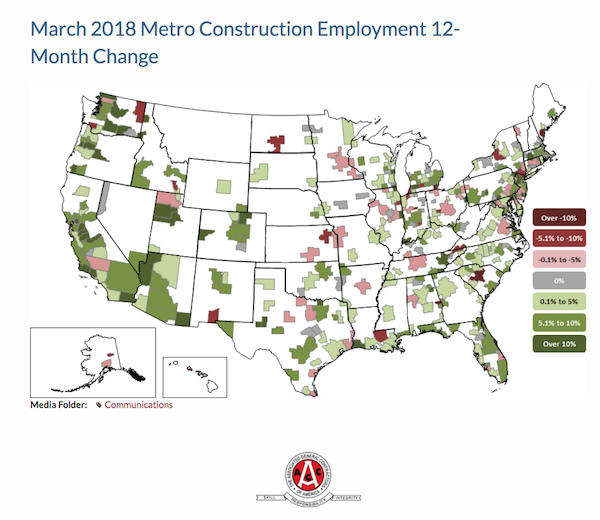Construction jobs increase in 245 metros between March 2017 and 2018
Houston-The Woodlands-Sugar Land, Texas and Weirton-Steubenville, W.Va.-Ohio experience largest year-over-year gains.
Construction employment increased in 245 out of 358 metro areas between March 2017 and March 2018, declined in 67 and stagnated in 46, according to a new analysis of federal employment data released today by the Associated General Contractors of America. Association officials said that the new figures come amid questions about how a possible trade war and long-term infrastructure funding shortfalls will impact the construction sector.

"While firms in many parts of the country continue to expand, there is a growing number of threats that could undermine future employment growth in the sector," said Stephen E. Sandherr, the association's chief executive officer. "Among the top threats to future construction growth are the risk of a trade war and long-term infrastructure funding challenges."
Houston-The Woodlands-Sugar Land, Texas added the most construction jobs during the past year (10,700 jobs, 5 percent), followed by
- Phoenix-Mesa-Scottsdale, Ariz. (9,500 jobs, 9 percent);
- Dallas-Plano-Irving, Texas (7,800 jobs, 6 percent) and
- Riverside-San Bernardino-Ontario, Calif. (7,200 jobs, 8 percent).
The largest percentage gains occurred in the
- Weirton-Steubenville, W.Va.-Ohio metro area (29 percent, 400 jobs), followed by
- Merced, Calif. (26 percent, 600 jobs);
- Wenatchee, Wash. (26 percent, 600 jobs) and
- Midland, Texas (23 percent, 6,000 jobs).
The largest job losses from March 2017 to March 2018 were in
- Baton Rouge, La. (-3,200 jobs, -6 percent), followed by
- Columbia, S.C. (-2,200 jobs, -11 percent);
- Minneapolis-St. Paul-Bloomington, Minn.-Wisc. (-1,700 jobs, -2 percent);
- Newark, N.J.-Pa. (-1,700 jobs, -4 percent) and
- Montgomery County-Bucks County-Chester County, Pa. (-1,600 jobs, -3 percent).
The largest percentage decreases for the year were in
- Auburn-Opelika, Ala. (-34 percent, -1,300 jobs), followed by
- Monroe, Mich. (-17 percent, -400 jobs);
- Portland-South Portland, Maine (-11 percent, -1,000 jobs) and
- Columbia, S.C. (-11 percent, -2,200 jobs).
Association officials said that trade disputes that could arise from the President's newly-imposed tariffs and long-term infrastructure funding shortfalls could threaten future construction employment growth. They noted that many construction firms have already experienced significant increases in what they pay for steel products. Meanwhile, long-term funding shortfalls for infrastructure improvements could undermine demand for many firms' services.
"The biggest threats to future construction growth are man-made: trade wars and funding shortfalls," said Stephen E. Sandherr, the association's chief executive officer. "Fortunately, Washington officials can help ensure future economic growth by avoiding a trade war and enacting long-term infrastructure funding."
View the metro employment data by rank and state. View metro employment map.














